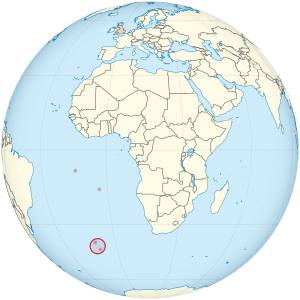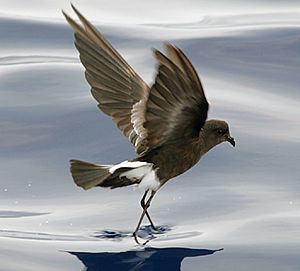List of birds of Tristan da Cunha facts for kids
Welcome to the amazing world of birds found on Tristan da Cunha! This small group of islands is in the middle of the South Atlantic Ocean. It's a special place for many birds. Here, you'll discover the different types of birds that live on or visit these remote islands.
Scientists have recorded 93 different bird species here. Some of these birds are super unique! Eight species are found nowhere else on Earth. We call these endemic species. Sadly, one bird species that used to live here is now extinct, meaning it's gone forever.
To help you understand, we've used some special tags:
- A means Accidental: This bird rarely visits Tristan da Cunha. It's usually just passing through!
- E means Endemic: This bird lives only on Tristan da Cunha and nowhere else.
- Ex means Extinct: This bird used to live here but is now gone forever.
The way we've organized these birds, with their common and scientific names, follows a worldwide bird checklist from 2022.
Contents
- Ducks, Geese, and Waterfowl
- Cuckoos
- Nightjars and Allies
- Rails, Gallinules, and Coots
- Sheathbills
- Plovers and Lapwings
- Sandpipers and Allies
- Skuas and Jaegers
- Gulls, Terns, and Skimmers
- Tropicbirds
- Penguins
- Albatrosses
- Southern Storm-Petrels
- Northern Storm-Petrels
- Petrels and Shearwaters
- Herons, Egrets, and Bitterns
- Tyrant Flycatchers
- Swallows
- Leaf Warblers
- Thrushes
- Tanagers
- See also
Ducks, Geese, and Waterfowl
These birds are part of the Anseriformes group. They are excellent swimmers and divers. Their feathers have a special oily coating. This helps them stay dry in the water.
- Yellow-billed teal, Anas flavirostris (A)
Cuckoos
Cuckoos are found all over the world. They come in many sizes and colors. Some cuckoos are known for laying their eggs in other birds' nests.
- Yellow-billed cuckoo, Coccyzus americanus (A)
Nightjars and Allies
Nightjars are birds that are active at night. They have special feathers that help them blend in with trees and the ground. This camouflage keeps them safe during the day.
- Common nighthawk, Chordeiles minor (A)
Rails, Gallinules, and Coots
These birds are often shy and hard to spot. Many island rails cannot fly. Sadly, many flightless island birds have disappeared over the last 500 years. Gallinules are less shy. They are usually found near water.
- Inaccessible Island rail, Atlantisia rogersi (E)
- Paint-billed crake, Neocrex erythrops (A)
- Tristan moorhen, Gallinula nesiotis (Ex)
- Gough moorhen, Gallinula comeri (E)
- Red-gartered coot, Fulica armillata (A)
- Purple gallinule, Porphyrio martinicus (A)
Sheathbills
Sheathbills are scavengers. This means they eat leftover food or dead animals. They live in cold, Antarctic areas. They have white feathers and look a bit like plump doves.
- Snowy sheathbill, Chionis albus (A)
Plovers and Lapwings
Plovers are small wading birds. They live near coasts and inland waters worldwide. Two types of plovers have been seen on Tristan da Cunha.
- Common ringed plover, Charadrius hiaticula (A)
- Rufous-chested dotterel, Charadrius modestus (A)
Sandpipers and Allies
This is a large group of shorebirds. It includes sandpipers, curlews, and snipes. Most of these birds find small bugs and worms to eat in mud or soil.
- Upland sandpiper, Bartramia longicauda (A)
- Whimbrel, Numenius phaeopus (A)
- Ruddy turnstone, Arenaria interpres (A)
- Sharp-tailed sandpiper, Calidris acuminata
- Sanderling, Calidris alba (A)
- White-rumped sandpiper, Calidris fuscicollis (A)
- Pectoral sandpiper, Calidris melanotos (A)
- Red phalarope, Phalaropus fulicarius (A)
- Spotted sandpiper, Actitis macularius (A)
- Solitary sandpiper, Tringa solitaria (A)
- Common greenshank, Tringa nebularia (A)
- Lesser yellowlegs, Tringa flavipes (A)
Skuas and Jaegers
Skuas and jaegers are medium to large birds. They usually have grey or brown feathers. They often have white marks on their wings. These birds nest on the ground. They travel very long distances when they migrate.
- Chilean skua, Stercorarius chilensis (A)
- Brown skua, Stercorarius antarctica
- Parasitic jaeger, Stercorarius parasiticus (A)
- Long-tailed jaeger, Stercorarius longicaudus (A)
Gulls, Terns, and Skimmers
This family includes gulls, terns, and skimmers. Gulls are usually grey or white. They often have black on their heads or wings. They have strong bills and webbed feet. Terns are also often grey or white. Most terns dive into the water to catch fish. Many terns can live for over 30 years!
- Franklin's gull, Leucophaeus pipixcan (A)
- Kelp gull, Larus dominicanus (A)
- Brown noddy, Anous stolidus
- Arctic tern, Sterna paradisaea (A)
- Antarctic tern, Sterna vittata
Tropicbirds
Tropicbirds are seabirds. They were once thought to be related to pelicans. Now, scientists know they belong to a different group.
- Red-tailed tropicbird, Phaethon rubricauda (A)
Penguins
Penguins are amazing birds of the southern oceans. Most penguins are black and white. Only one penguin species lives north of the equator.
- King penguin, Aptenodytes patagonicus (A)
- Gentoo penguin, Pygoscelis papua (A)
- Chinstrap penguin, Pygoscelis antarcticus (A)
- Macaroni penguin, Eudyptes chrysolophus (A)
- Southern rockhopper penguin, Eudyptes chrysocome
- Moseley's rockhopper penguin, Eudyptes moseleyi
Albatrosses
Albatrosses are very large seabirds. They have huge wingspans, often over a meter wide! Most live in the southern oceans.
- Yellow-nosed albatross, Thalassarche chlororhynchos
- Gray-headed albatross, Thalassarche chrysostoma
- White-capped albatross, Thalassarche cauta
- Salvin's albatross, Thalassarche salvini (A)
- Black-browed albatross, Thalassarche melanophris
- Sooty albatross, Phoebetria fusca
- Light-mantled albatross, Phoebetria palpebrata
- Wandering albatross, Diomedea exulans
Southern Storm-Petrels
Storm-petrels are the smallest seabirds. They are related to petrels. They eat tiny sea creatures and small fish. They often pick food from the water's surface while hovering. Their flight can look like a bat's flight.
- Wilson's storm-petrel, Oceanites oceanicus
- Gray-backed storm-petrel, Garrodia nereis
- White-faced storm-petrel, Pelagodroma marina
- White-bellied storm-petrel, Fregetta grallaria
- Black-bellied storm-petrel, Fregetta tropica
Northern Storm-Petrels
These storm-petrels look and act much like the southern ones. However, genetic differences show they belong to a separate family.
- Leach's storm petrel, Hydrobates leucorhoa
Petrels and Shearwaters
Petrels and shearwaters are often called "tubenoses." This is because they have tube-like structures on their beaks. They use these tubes to get rid of extra salt from their bodies.
- Southern giant-petrel, Macronectes giganteus
- Northern giant-petrel, Macronectes halli
- Southern fulmar, Fulmarus glacialoides
- Cape petrel, Daption capensis
- Kerguelen petrel, Aphrodroma brevirostris
- Great-winged petrel, Pterodroma macroptera
- Soft-plumaged petrel, Pterodroma mollis
- White-headed petrel, Pterodroma lessonii
- Juan Fernandez petrel, Pterodroma externa
- Atlantic petrel, Pterodroma incerta
- Blue petrel, Halobaena caerulea (A)
- Broad-billed prion, Pachyptila vittata
- MacGillivray's prion, Pachyptila macgillivrayi
- Antarctic prion, Pachyptila desolata
- Slender-billed prion, Pachyptila belcheri
- Gray petrel, Procellaria cinerea
- White-chinned petrel, Procellaria aequinoctialis
- Spectacled petrel, Procellaria conspicillata
- Cory's shearwater, Calonectris diomedea (A)
- Great shearwater, Ardenna gravis
- Sooty shearwater, Ardenna grisea
- Subantarctic shearwater, Puffinus elegans
- Tropical shearwater, Puffinus bailloni
- Common diving-petrel, Pelecanoides urinatrix
Herons, Egrets, and Bitterns
Herons are tall, long-legged water birds. Most of them eat fish and other small creatures found in ponds and wetlands. Six different species have been seen on Tristan da Cunha.
- Cocoi heron, Ardea cocoi (A)
- Great egret, Ardea alba (A)
- Snowy egret, Egretta thula (A)
- Little blue heron, Egretta caerulea (A)
- Cattle egret, Bubulcus ibis (A)
- Striated heron, Butorides striata (A)
Tyrant Flycatchers
These birds are found across North and South America. They look a bit like Old World flycatchers. However, they are stronger and have tougher beaks. Most of them eat insects.
- Eastern kingbird, Tyrannus tyrannus (A)
Swallows
Swallows are birds that are great at catching insects while flying. They have sleek bodies and long, pointed wings. Their feet are good for perching, but not so much for walking.
- Barn swallow, Hirundo rustica (A)
- Cliff swallow, Petrochelidon pyrrhonota (A)
Leaf Warblers
This family of birds is found in many places. They are small, insect-eating birds. They mostly look for food in trees.
- Willow warbler, Phylloscopus trochilus (A)
Thrushes
Thrushes are a group of birds often found in the Old World. They are plump and have soft feathers. They are small to medium-sized birds that eat insects or sometimes everything. Many thrushes have beautiful songs.
- Tristan thrush, Turdus eremita (E)
Tanagers
This large bird family includes true tanagers. It also has other species often called "finches." These finches are not part of the true finch family.
- Gough Island finch, Rowettia goughensis (E)
- Inaccessible Island finch, Nesospiza acunhae (E)
- Nightingale Island finch, Neospiza acunhae (E)
- Wilkins's finch, Nesospiza wilkinsi (E)
See also
- List of birds
- Lists of birds by region



